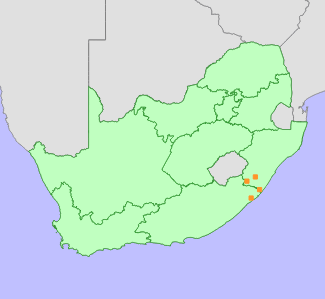|
Scientific Name | Geranium sparsiflorum R.Knuth |
Higher Classification | Dicotyledons |
Family | GERANIACEAE |
Synonyms | Geranium alticola Schltr. ex R.Knuth |
National Status |
Status and Criteria | Vulnerable B1ab(iii) |
Assessment Date | 2007/09/17 |
Assessor(s) | L. von Staden |
Justification | EOO 5500 km², there are only five known locations, four of which are from herbarium collections made in the late 1800s. It is probably extinct at some of these locations, but equally there may be as many as 10 locations, as many areas of the Transkei remain botanically poorly explored. Surveys are required to relocate subpopulations at historical locations. Habitat loss is continuing, especially in the Eastern Cape, it is assumed that this species is declining. |
Distribution |
Endemism | South African endemic |
Provincial distribution | Eastern Cape, KwaZulu-Natal |
Range | Southern KwaZulu-Natal between Kokstad, Ixopo and Weza. Also around Lusikisiki (Eastern Cape). |
Habitat and Ecology |
Major system | Terrestrial |
Major habitats | Midlands Mistbelt Grassland, Moist Coast Hinterland Grassland, Drakensberg Foothill Moist Grassland |
Description | Moist montane grasslands and Ngongoni Veld, in seasonally moist areas, 500-1700 m. |
Threats |
| This species is severely threatened by habitat transformation across its range. Most moist montane grassland in southern KwaZulu-Natal has been transformed to commercial forestry plantations and agriculture. In communally owned lands in southern KwaZulu-Natal and the Eastern Cape, grasslands are severely degraded as a result of excessive overgrazing and over-burning.
Across the provincial border from Weza into the Eastern Cape, many new forestry plantations are being established (C.R. Scott-Shaw pers. comm.) and much more is planned for the future. This species is likely to continue losing habitat, which is ideally suited to forestry.
Around Lusikisiki much of the grasslands have been transformed into commercial tea plantations at Magwa, and subsistence agriculture elsewhere. |
Population |
Population trend | Decreasing |
Notes |
| The disjunction in the distribution records of this species may be a result of collector intensity. While intervening Pondoland areas along the coast between Ixopo and Lusikisiki have been well collected, especially the Umtamvuna and Mkambati Nature Reserves, the more inland Ngongoni grasslands are relatively poorly known, as the deep rural areas of the former Transkei homeland are still fairly inaccessible, mainly due to very poor road infrastructure. It is quite possible that this species may have a continuous distribution in the Ngongoni grasslands between Weza and Lusikisiki. However, most Ngongoni grasslands are severely degraded due to excessive burning to stimulate new growth in the sour grasslands, as well as severe overgrazing, to such an extent that these grasslands have been reduced to a virtual monoculture of the unpalatable Ngongoni grass (Aristida junciformis) (C.R. Scott-Shaw pers. comm.). This species is very likely to be threatened as well if it occurs in these areas.
Schlechter collected another specimen of this species (Schlechter 6994), however the locality indicated on the specimen, Van Reenen in far northern KwaZulu-Natal, is quite likely a mistake. According to Hilliard and Burtt (1985), the locality on the specimen appears to have been written by someone other than Schlechter, and it may have been a mistaken assumption based on the fact that the last of Schlechter's specimens of his 1891-95 tour of South Africa (Schlechter 6992) was collected at Van Reenen. Since this species has never been collected again in the Van Reenen area, Hilliard and Burtt (1985) chose to exclude this locality from the distribution range of this species. This decision was followed in this assessment. |
Assessment History |
Taxon assessed |
Status and Criteria |
Citation/Red List version | | Geranium sparsiflorum R.Knuth | VU B1ab(iii) | Raimondo et al. (2009) | | Geranium sparsiflorum R.Knuth | Data Deficient | Scott-Shaw (1999) | |
Bibliography |
Hilliard, O.M. and Burtt, B.L. 1985. A revision of Geranium in Africa south of the Limpopo. Notes from the Royal Botanic Garden Edinburgh 42(2):171-225.
Raimondo, D., von Staden, L., Foden, W., Victor, J.E., Helme, N.A., Turner, R.C., Kamundi, D.A. and Manyama, P.A. 2009. Red List of South African Plants. Strelitzia 25. South African National Biodiversity Institute, Pretoria.
Scott-Shaw, C.R. 1999. Rare and threatened plants of KwaZulu-Natal and neighbouring regions. KwaZulu-Natal Nature Conservation Service, Pietermaritzburg.
|
Citation |
| von Staden, L. 2007. Geranium sparsiflorum R.Knuth. National Assessment: Red List of South African Plants version 2024.1. Accessed on 2025/11/07 |
 Comment on this assessment
Comment on this assessment


